ORDER
Falconiformes
FAMILY
Accipitridae
GENUS & SPECIES
KEY FEATURES
A first-rate fisher, the fish eagle skillfully seizes prey, usually catching its quota early in the day Interlocked mating pairs engage in whirling aerial courtship displays that can end in death Known throughout Africa for its song that peals out continuously from sunrise to sunset
WHERE IN THE WORLD?
Throughout sub-saharan Africa; from Senegal and Gambia in the west, east through Ethiopia, Sudan, Kenya and Uganda

Lifecycle
After awakening the continent with its song, the African fish eagle strikes quickly to land its daily meal, then retires to its perch to closely guard its territory from intruders.
HABITAT
Whether lake, river or creek, water always abounds in the African fish eagle’s territory Near Lake Victoria or the lakes of Kenyan Rift Valley a pair of eagles may require less than 1 sq. mile of water to find enough food. If the pair inhabits an area next to a small river, however; they may need 15 miles of water: The African fish eagle spends most of the day perched in a large tree that overlooks the water; preferring fig and acacia trees.
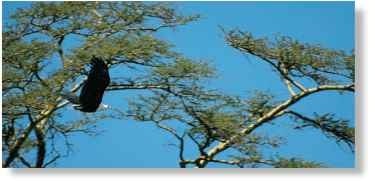
A Soaring search
An African fish eagle soars high above a lake that provides an abundance of fish.
An African fish eagle in captivity lived 40 years, more than twice the average lifespan of one in the wild.
The call of the African fish eagle is so widely heard that it is known as “the voice of Africa.”
BREEDING
During the breeding season displays become very intense. Rare among other eagles but common among sea and fish eagles, the whirling ritual occurs when a courting pair soars, locks claws and then falls wing over wing toward the ground.The birds will not release until the display is over, which occasionally can end in death if the entwined birds crash to the ground. When the female is ready to mate, she lowers her head and raises her tail so that her whole body is parallel to the ground.The male then jumps or flies onto her backThe pair usually mates for life.They build their large stick-nest in a tree and use this nest year after year, adding new material to it for each breeding season.
FOOD & FEEDING
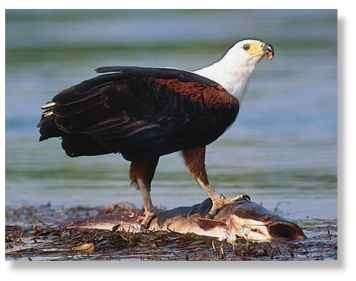
The fish eagle hunts its prey from perches overlooking the water If it is lucky, it will catch two live fish in about 10 minutes and be done hunting for the day Its favorites are catfish and lungfish, and it will occasionally snatch these from herons, pelicans and storks.Young flamingos, ducks, storks and herons are targets, as are lizards and turtles.The fish eagle plucks feathers from birds and scales fish before eating the animals.
After food is ingested, it can be stored in a fleshy pouch in the neck called a crop; this pouch will hold over 2 lbs. of food. It allows the eagle to gorge itself when large amounts of food are available, then regurgitate it for later consumption.
CONSERVATION
Current populations of the African fish eagle remain stable.Very low levels of pesticides are now found in the food chain of the African fish eagle, but humans present the greatest threat to the eagle’s future. Conservation of land and clean water is needed to maintain the population.
A RAPTORIAL RAID

1 Predatory perch
Sitting atop a tall tree, the African fish eagle has a perfect view of the lake in its square-mile territory.

2 Target in sight
Swooping at 20 mph, the eagle glides with its feet extended and talons ready to strike at a Nile perch.

3 Heavy load
It drags the perch, which is too heavy to be carried while flying, along the surface.The eagle gathers speed and…
4 Well-earned meal
…lifts its meal onto the bank. The eagle uses its beak to pull the scales off the perch before enjoying its feast.
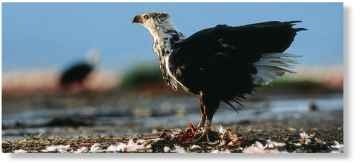
► Growing up The fish eagle’s plumage goes through four stages before adulthood.
BEHAVIOR
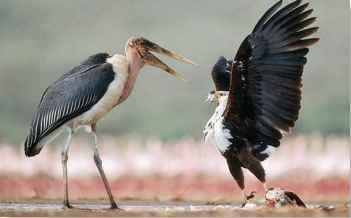
A It’s mine
Fiercely protective of its kills, the fish eagle will attack any potential thief, including a marabou stork.
Awakening before dawn, the eagle begins its serenade, a song well known across Africa. ^r About 40 minutes before sunrise, the air throughout the sub-Sahara fills with the chorus of singing pairs.The calls serve as a territorial signal. The “tune” may be produced in flight while the eagle searches for potential prey. When perched and singing, the eagle theatrically throws its head back and belts out its song, which bears some resemblance to the call of the American bald eagle.The African fish eagle sings this loud, cheerful song throughout the day, often in female-initiated duets. A pair will normally remain together after the breeding season.
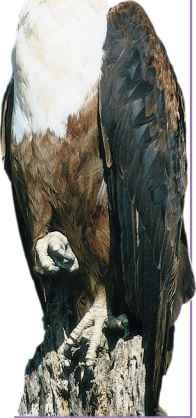
► Powerful pose Perched high in a tree, the eagle towers above its territory.
PROFILE
African Fish Eagle
Adept at fishing, the keen-eyed African fish eagle spots prey from high on its perch, then dives to “hook” its victim using dagger-sharp talons.
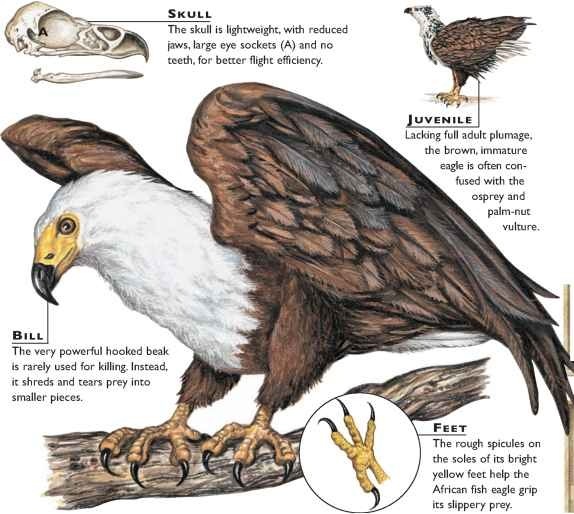
CREATURE COMPARISONS
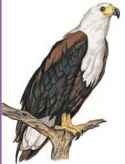
African fish eagle
As its name implies, the white-tailed eagle (Haliaeetus albicilla) has a white tail, but lacks the distinctive white head of the African fish eagle. Weighing in at 7-14 lbs. the white-tailed is heavier than the African fish eagle and, in both species, females are larger than the males.The white-tailed eagle inhabits Europe and Asia, but rarely Africa. Like the African fish eagle, it includes large areas of water in its territory The white-tailed eagle shares the scaly, fish-grabbing talons and the dietary habits of the African fish eagle, subsisting mainly on freshly caught fish.
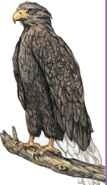
White-tailed eagle
VITAL STATISTICS |
|
| Weight | Male 4-6 lbs.; female 7-9 lbs |
| Length | 26-33″ |
| Wingspan | 7′ |
| Sexual Maturity | 4 years |
| | Breeding Season | Varies according to region |
| Number of Eggs | 1-3 |
| Incubation : Period | 44 days |
| Fledging Period | 65-75 days |
| Breeding ;Interval | 6 months to 1 year |
| Typical fDiet | Large fish |
| Lifespan | Up to 15 years in the wild |
• Often called raptors, the hawk order Falconiformes includes hawks, eagles, vultures, falcons, the secretary bird and the osprey. These primarily carnivorous birds all have hooked beaks, strong feet with curved talons for catching prey, large eyes and wings built for soaring. Of the world’s more than 220 species of raptors, over 70 live in Africa.

